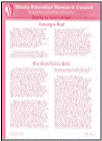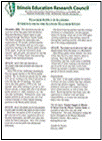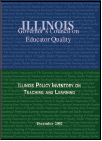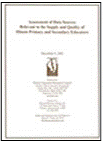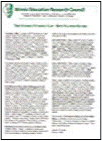IERC Publications
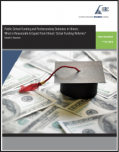 Public School Funding and Postsecondary Outcomes in Illinois: What is Reasonable to Expect from Illinois’ School Funding Reforms? (2018-1)
Public School Funding and Postsecondary Outcomes in Illinois: What is Reasonable to Expect from Illinois’ School Funding Reforms? (2018-1)
Derek A. Houston, University of Oklahoma
This paper explores the relationships between differential public school funding across Illinois high schools and six educational outcomes: ACT composite scores, ACT math scores, enrollment in any postsecondary education, enrollment in four-year institutions, attainment of any postsecondary degree, and attainment of four-year degrees. It reviews the Illinois school funding policies that were in place at the time of data collection and their regressive structure. Using a unique longitudinal dataset for the Illinois public high school junior class of 2002, it finds significant and positive relationships between higher public school funding and each of the six postsecondary-related outcomes through both hierarchical linear and logistic regression modeling. These findings highlight how funding policies may have affected educational mobility of Illinois public school students.
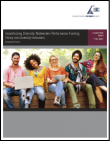 Incentivizing Diversity: Midwestern Performance Funding Policy and Diversity Indicators (FFR 2017-1)
Incentivizing Diversity: Midwestern Performance Funding Policy and Diversity Indicators (FFR 2017-1)
Sosanya Jones, EdD
This report presents a multi-case study examining postsecondary performance funding policies in four Midwestern states (including Illinois) and explores how each policy’s metrics and weights address racial diversity in higher education. This important research addresses gaps in the literature concerning the development and use of state performance funding policy to incentivize racial diversity goals in higher education. Dr. Jones provides recommendations to help policymakers move past symbolic efforts to address racial diversity in higher education and increase the participation and retention of underrepresented students of color, and guidance for researchers planning future studies on performance funding policy and institutional diversity goals.
Full Document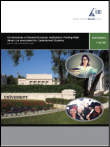 Cornerstones of Student Success: Institutions Yielding High Return on Investment for Underserved Students (2017-5)
Cornerstones of Student Success: Institutions Yielding High Return on Investment for Underserved Students (2017-5)
Janet K. Holt and Daniel Q. Duffy
This analysis of publicly available institutional data on graduation rates, earnings, student loan debt and loan default rates, the report ranks 55 public, nonprofit private, and for-profit private institutions in Illinois identifies the Top 7 for underserved students. This is the second in a series of reports on underserved students that she has led at the IERC. The first report, Degrees with Less Debt, identified five Missouri institutions that were graduating underrepresented students with less debt and analyzed the strategies the institutions are using to accomplish this. Together, these two reports put the focus on institutions that are admitting a fair number of low-income students and helping them graduate and gain employment with less debt. These reports highlight universities are doing an excellent job of serving students who have traditionally been under-served.
Full DocumentExecutive Summary Research Brief: Do High School Students Know Their Parents’ Income?
Research Brief: Do High School Students Know Their Parents’ Income?
Drew M. Anderson, University of Wisconsin-Madison, and Janet K. Holt, Southern Illinois University Edwardsville
Most students finish high school with low levels of financial knowledge, yet they are months away from important decisions about how to finance college. Students may not know about family finances, even though parental income is a key determinant of financial aid for college. This study measures the financial knowledge of high school students by comparing survey answers to actual measures of parental income from financial aid applications in a statewide sample. We find that students can accurately state parental income 24% of the time, within $15,000. Overreporting of parental income is much more common than underreporting. We explore potential causes and consequences of misreporting, and implications for research using self-reported income.
Research Brief
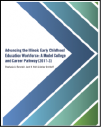 Advancing the Illinois Early Childhood Education Workforce: A Model College and Career Pathway (2017-3)
Advancing the Illinois Early Childhood Education Workforce: A Model College and Career Pathway (2017-3)
Stephanie A. Bernoteit, Janet K. Holt, and Amber Kirchhoff
The early childhood educator workforce has widely ranging credentials and degrees, qualifications and compensation, typically varying by setting. Yet, there is a national call for aligning and strengthening requirements for preparation of the early childhood workforce to ensure that young children thrive and reach their potential at each stage in their development. This policy brief, Advancing the Illinois Early Childhood Education Workforce: A Model College and Career Pathway, proposes and describes a pathway model that accomplishes these goals, building on the existing early childhood credentialing and postsecondary degree structure in Illinois to create a seamless system of vertically-aligned preparation for the early childhood workforce with multiple entry and exit paths to fit the needs of this diverse workforce.
Policy Brief Infographic
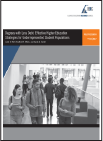 Degrees with Less Debt: Effective Higher Education Strategies for Underrepresented Student Populations (2017-2)
Degrees with Less Debt: Effective Higher Education Strategies for Underrepresented Student Populations (2017-2)
Janet K. Holt, Bradford R. White, and Sarah K. Terrell
This report describes an IERC study, led by Executive Director Janet Holt and commissioned by St. Louis Graduates, a collaborative network whose mission is to increase degree completion for low-income students, first-generation students, and students of color from St. Louis. The report addresses two key questions: 1) which institutions are doing the best in supporting low-income, first-generation students and students of color through college completion with low debt? and 2) what strategies are these institutions using to facilitate these results?
Starting with a list of 20 four-year institutions in Missouri and Illinois where St. Louis students most often attend college, a Success metric was developed to determine which institutions were best supporting underrepresented students. From this study, a group of five institutions rose to the top. In the second phase of this project, we interviewed administrators in the areas of academic and student affairs, enrollment management, and financial aid as well as a group of students, from each of these five institutions to find the key ingredients of their “secret sauce” in supporting underrepresented students to graduation with less debt.
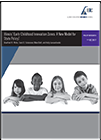 Illinois’ Early Childhood Innovation Zones: A New Model for State Policy? (2017-1)
Illinois’ Early Childhood Innovation Zones: A New Model for State Policy? (2017-1)
Bradford R. White, Carol E. Colaninno, Mimi Doll, and Holly Lewandowki
Illinois’ Early Childhood Innovation Zones: A New Model for State Policy? is an evaluation of efforts made by Illinois Action for Children to spur experimentation with systemic change strategies to increase the number of Illinois’ most vulnerable children enrolled in high quality early learning programs. Funded by a Race to the Top-Early Learning Challenge grant, this Innovation Zones initiative supported capacity building efforts in 11 underserved Illinois communities. The initiative targeted improvement strategies for two primary outcome measures: 1) enrolling and serving more children (birth to kindergarten) from priority populations in early learning programs; and 2) increasing the number of early learning programs participating in the state’s quality rating and improvement system. Over the duration of the grant, zones obtained modest gains in enrollment overall and quality ratings increased across all zones and within each zone. This initiative marks a new approach to delivering statewide education policy allowing communities to develop context-sensitive strategies and promoted creative solutions to common problems in the early childhood system.
Full DocumentExecutive Summary Research Highlights
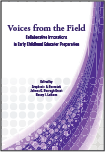 Voices from the Field: Collaborative Innovations in Early Childhood Educator Preparation (2016)
Voices from the Field: Collaborative Innovations in Early Childhood Educator Preparation (2016)
Stephanie A. Bernoteit, Johnna C. Darragh Ernst, and Nancy I. Latham (Eds)
Voices from the Field: Collaborative Innovations in Early Childhood Educator Preparation is jointly published by the IERC and IBHE, and highlights the accomplished work of many of our state’s two- and four-year faculty to redesign early childhood educator preparation programs to meet regional and state workforce needs. Stephanie Bernoteit, IBHE, Johnna Darragh Ernst, Heartland Community College and Nancy Latham, Illinois State University edited this book. The project manager was Janet Holt, IERC Executive Director, with considerable assistance from Jennifer Barnhart, IERC Research Associate, and Rebecca Butler, professor emeritus, NIU.
This edited book has chapters authored by EC faculty from both the 2-year and 4-year sectors and provides clear, tangible examples of how universities across Illinois worked together, often with regional employers, to design pathways for early childhood educators to earn the state’s industry-recognized Gateways credentials while taking college coursework leading to degrees. Each chapter has a unique focus and together, their “Voices” provide significant insight into the innovative partnerships that the EPPI grants inspired. The editors have been at the forefront of the early childhood credentialing and competency assessment design in Illinois.
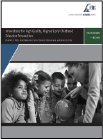 Innovations for High Quality, Aligned Early Childhood Educator Preparation (2016-3)
Innovations for High Quality, Aligned Early Childhood Educator Preparation (2016-3)
Bradford R. White, Debra Mayconich Baron, Brenda K. Klostermann, and Daniel Q. Duffy
Early Childhood Educator Preparation Program Innovation (EPPI) grants were awarded to twenty partnerships of two- and four-year institutions to develop new models and innovations for early childhood educator preparation. This qualitative implementation study provides a systematic review of the innovations and strategies EPPI grant recipients utilized in addressing common barriers and practice-oriented issues experienced in early childhood educator preparation. Recipients used grant funds to design and implement a wide range of seamless pathways for degree and credential attainment through innovative articulation initiatives, systems for aligning assessments to demonstrate candidate attainment of key competencies, and strategies for advising and supporting transfer students. Promising practices to improve early math learning, bilingual/English language learning, infant/toddler development, and quality field experience placements were also developed.
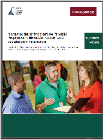 Navigating the Shift to Intensive Principal Preparation in Illinois: An In-depth Look at Stakeholder Perspectives (2016-2)
Navigating the Shift to Intensive Principal Preparation in Illinois: An In-depth Look at Stakeholder Perspectives (2016-2)
Bradford R. White, Amber Stitziel Pareja, Holly Hart, Brenda K. Klostermann, Michelle Hanh Huynh, Mary Frazier-Meyer, and Janet K. Holt
This report from the Illinois Education Research Council (IERC) at Southern Illinois University Edwardsville, in partnership with the University of Chicago Consortium on School Research (UChicago Consortium), assesses the progress of sweeping legislation to redesign the way school principals in Illinois are prepared, with the goal of improving schools statewide through higher quality leadership. The report summarizes findings from a two-year study assessing the progress of these ambitious reforms and describing the changes that occurred as a result of the new policy.
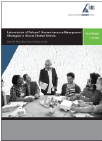 Laboratories of Reform? Human Resource Management Strategies in Illinois Charter Schools (2016-1)
Laboratories of Reform? Human Resource Management Strategies in Illinois Charter Schools (2016-1)
Bradford R. White
The purpose of this study was to investigate how Illinois charter schools are leveraging the flexibility they are provided by law to innovate in the area of human resource management, and to explore the relationships between HR practices and school outcomes. To do this, we conducted surveys and interviews with administrators from 27 Illinois charter schools to describe the ways they recruitment, develop, and retain teachers. We create a typology of four broad HR strategies that are utilized to a greater or lesser extent at each school: 1) incentivist reforms; 2) teacher support and empowerment; 3) information-rich decision-making, and 4) mission-driven practice. Next, we compare these HR strategies with data on teacher retention, school climate, and student achievement to measure the relationship between human resources practices and school outcomes. The analysis reveals evidence suggesting that incentivist practices may be associated with increased math achievement, but this is dependent on how achievement growth is measured. The study also shows that the newest charter schools were considerably less likely to use incentivist practices than their more established counterparts, and that teacher empowerment and information-rich decision-making practices were associated with certain measures to school climate.
Full Document Executive Summary Research Highlight Policy Brief Infographic
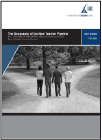 The Impact of Faculty Development on Teacher Self-Efficacy, Skills and Perspectives (FFR 2015-1)
The Impact of Faculty Development on Teacher Self-Efficacy, Skills and Perspectives (FFR 2015-1)
Melodie A. Rowbotham
IERC releases its inaugural faculty fellows report by 2013/14 IERC faculty fellow, Dr. Melodie Rowbotham. This study examined the relationship of faculty development on teaching to faculty self-assessment of teaching skills and their teacher self-efficacy.
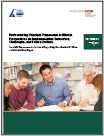 Restructuring Principal Preparation in Illinois: Perspectives on Implementation Successes, Challenges, and Future Outlook (2015-3)
Restructuring Principal Preparation in Illinois: Perspectives on Implementation Successes, Challenges, and Future Outlook (2015-3)
Brenda K. Klostermann, Amber Stitziel Pareja, Holly Hart, Bradford R. White, and Michelle Hanh Huynh
The goals of the current mixed methods study—the Illinois Principal Preparation Implementation Review Project (I-PREP)—are to describe how the new policy is being implemented, learning which aspects of the implementation have been challenging and why they present challenges, and how programs are addressing challenges and realizing improvements in the preparation of their candidates. This report presents findings from the first phase of the study. Results of interviews with program representatives and key Illinois education stakeholders showed the majority of those interviewed support the goals of the new policy and have a positive outlook on its future impact of principal preparation in Illinois. Although some concerns about the implementation were expressed, most believe the redesigned principal preparation programs will ultimately create better prepared school administrators, improved student achievement, and more successful schools. The final report, due in summer 2016, will integrate the findings from this interim report, site visits with selected programs, and a survey with all programs to provide research-based insights in how to improve the policy and its implementation.
T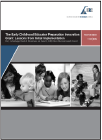 he Early Childhood Educator Preparation Innovation Grant: Lessons from Initial Implementation (2015-2)
he Early Childhood Educator Preparation Innovation Grant: Lessons from Initial Implementation (2015-2)
Eric J. Lichtenberger, Brenda K. Klostermann, and Daniel Q. Duffy
In this implementation study, we reveal the barriers to project-specific goal attainment and the catalysts that allowed the partnerships to meet their objectives. This research is informative for policy development specific to articulation agreement, current and future early childhood innovation grantees, as well as others attempting to build stronger and more authentic partnerships between community colleges and four-year institutions.
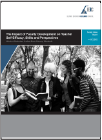 The Geography of the New Teacher Pipeline (2015-1)
The Geography of the New Teacher Pipeline (2015-1)
Eric J. Lichtenberger, Bradford R. White, and Karen J. DeAngelis
The purpose of this study was to demonstrate how data on the geography of Illinois’ new teacher pipeline can be used to inform the design of policies and practices to improve the supply of academically skilled, diverse individuals into teaching in the state’s public schools. This study builds on a prior IERC study which connects data for two cohorts of Illinois students, the public high school classes of 2002 and 2003. To address the research questions regarding the role that geography plays in where new teachers obtain their first teaching employment, we focus our analyses on the 7,209 new teachers who emerged from these two Illinois high school cohorts. The study establishes that labor markets for new teachers overall tend to be quite small geographically and that the geographic size of new teacher labor markets was more closely linked to characteristics of a teacher’s high school than to his or her academic qualifications. Other findings suggests that all new teachers, not just those in urban environments, will need to be prepared for the possibility of working in substantially different educational settings from what they experienced as students.
Full Document Executive Summary Full Doc with Audio
 Who Has Access to Dual Credit in Illinois? Examining High School Characteristics and Dual Credit Participation Rates (2013-4)
Who Has Access to Dual Credit in Illinois? Examining High School Characteristics and Dual Credit Participation Rates (2013-4)
Jason L. Taylor and Eric J. Lichtenberger
This research brief examines the relationship between high schools’ dual credit participation rate and key characteristics of high schools. The brief establishes that there are differences in students’ access to dual credit based on the observed characteristics of the high schools in which they enroll. For example, it was found that relative to high schools with low rates of dual credit participation, schools with high dual credit participation rates typically had fewer low-income students and more White students.
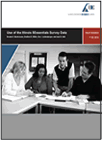 Use of the Illinois 5Essentials Survey Data (2014-2)
Use of the Illinois 5Essentials Survey Data (2014-2)
Brenda K. Klostermann, Bradford R. White, Eric J. Lichtenberger, and Janet K. Holt
The purpose of this study is to examine how Illinois school districts are utilizing the Illinois 5Essentials Survey results, particularly for school improvement, to determine challenges to successful implementation, and to make recommendations for improvements to the 5E Survey and implementation process for statewide use. We also summarize district/school stakeholders’ familiarity with the 5E Survey, perceived value of the survey, preferences for training, levels of supports, and reasons for not using the 5E Survey data. Examples of district’s promising practices for utilizing the 5E data are also highlighted.
 Outmigration and Human Capital: Homeward Bound or Gone for Good? (2014-1)
Outmigration and Human Capital: Homeward Bound or Gone for Good? (2014-1)
Eric J. Lichtenberger and Cecile Dietrich
This study examines the impact of student outmigration on Illinois employment and earnings. Our intent is for this study to inform policy to both decrease the outmigration of students and to collect appropriate data to track these students and quantify the impact.
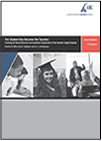 The Student Has Become the Teacher: Tracking the Racial Diversity and Academic Composition of the Teacher Supply Pipeline (2013-3)
The Student Has Become the Teacher: Tracking the Racial Diversity and Academic Composition of the Teacher Supply Pipeline (2013-3)
Bradford R. White, Karen J. DeAngelis, and Eric J. Lichtenberger
This study uses a unique, longitudinal statewide database to track students through the new teacher supply pipeline from high school through college and initial teacher certification. The report examines how each stage influences the characteristics of those who enter the teaching profession, with particular attention to academic skills and racial/ethnic diversity, characteristics that are of national and local concern because of their impact on teacher effectiveness.
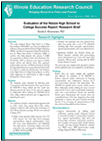 Evaluation of the Illinois High School to College Success Report (2013-2)
Evaluation of the Illinois High School to College Success Report (2013-2)
Brenda K. Klostermann
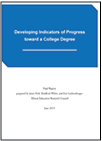 Developing Indicators of Progress toward a College Degree (June 2013)
Developing Indicators of Progress toward a College Degree (June 2013)
Janet K. Holt, Bradford R. White, and Eric J. Lichtenberger
This report examines the availability, continuity, and modeling of key student-level indicators that would be needed to indicate the progression of students toward a college degree. Moreover, this report investigates if the data elements that four-year institutions submit via the Illinois Higher Education Consortium model would contribute to our understanding and prediction of progression toward a college degree.
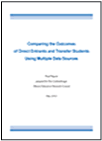 Comparing the Outcomes of Direct Entrants and Transfer Students Using Multiple Data Sources (May 2013)
Comparing the Outcomes of Direct Entrants and Transfer Students Using Multiple Data Sources (May 2013)
The purpose of this proof of concept project was to determine the potential benefits and limitations associated with merging student-level information traditionally maintained by higher education institutions with outside data sources. The institutional data parallels Illinois Higher Education Consortium (IHEC) data submissions, while the outside data sources provide the following information for students: 1) academic preparation and demographics; 2) national postsecondary enrollment and degree completion; and 3) Illinois-specific earnings and employment. Linking together such data would ultimately allow researchers and policymakers to examine the progress of individuals through high school, into college, and into the workforce, while demonstrating the types of research projects that can be scaled-up as the state’s longitudinal data system is fully implemented.
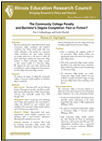 The Community College Penalty and Bachelor’s Degree Completion: Fact or Fiction? (2013-1)
The Community College Penalty and Bachelor’s Degree Completion: Fact or Fiction? (2013-1)
Eric J. Lichtenberger and Cecile Dietrich
This is part of a series of reports tracking Illinois college students’ postsecondary outcomes longitudinally from 2003 through 2010. In this study, we compared matched students who transferred from Illinois community colleges to students who entered and matriculated through Illinois four-year institutions to determine if there was a disadvantage for transfer students in terms of bachelor’s degree completion. Policy implications with regards to community college transfer students and the Illinois longitudinal data system are presented.
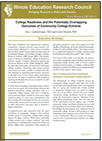 College Readiness and the Potentially Overlapping Outcomes of Community College Entrants (2012-3)
College Readiness and the Potentially Overlapping Outcomes of Community College Entrants (2012-3)
Eric J. Lichtenberger and Cecile Dietrich
This report describes the diverse, potentially overlapping range of student outcomes for community college entrants, such as vertical transfer, earning an associate degree, or earning a certificate while taking into consideration the differences in college readiness, as well as other student characteristics. This is part one of a two-part series of research reports that focus on the postsecondary outcomes of community college entrants. Part two will examine how college readiness and other pre-college, environmental, and institutional factors are related to bachelor’s degree completion for community college entrants who vertically transfer.
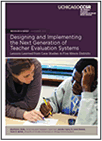 Designing and Implementing the Next Generation of Teacher Evaluation Systems: Lessons Learned from Case Studies in Five Illinois Districts (November 2012)
Designing and Implementing the Next Generation of Teacher Evaluation Systems: Lessons Learned from Case Studies in Five Illinois Districts (November 2012)
Illinois’ Performance Evaluation Reform Act (PERA) requires every district in the state to implement teacher evaluation systems by 2016-17 that address both teacher performance and student growth. In this report, the IERC collaborated with researchers from the University of Chicago Consortium on Chicago School Research (CCSR) to examine the experiences of five case study districts from throughout Illinois as they designed and implemented new evaluation systems. Based on qualitative interviews with members of each district’s evaluation committee, the brief provides a snapshot of how districts assessed and dealt with challenges around cultivating buy-in and understanding; using evaluations for instructional improvement; and reducing the burden on principals. In addition, it examines the on-going challenge of incorporating measures of student growth into teacher evaluation systems. The challenges faced by these early adopter districts and the strategies they used to overcome them may assist other districts as they engage in their own design and implementation processes.
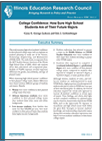 College Confidence: How Sure High School Students Are of Their Future Majors (2012-2)
College Confidence: How Sure High School Students Are of Their Future Majors (2012-2)
Casey E. George-Jackson and Eric J. Lichtenberger
This study examines high school students’ confidence in their planned college major with an emphasis on students planning to study one of the Science, Technology, Engineering, and Mathematics (STEM) fields. The study draws on responses from the ACT Student Interest Inventory of the Illinois High School Class of 2003, which asks students about their educational and occupational plans. Analysis of 75,698 responses revealed important differences by gender, race/ethnicity, and type of planned major.
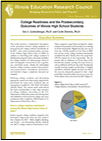 College Readiness and the Postsecondary Outcomes of Illinois High School Students (2012-1)Eric J. Lichtenberger and Cecile Dietrich
College Readiness and the Postsecondary Outcomes of Illinois High School Students (2012-1)Eric J. Lichtenberger and Cecile Dietrich
Eric J. Lichtenberger and Cecile Dietrich
This study presents longitudinal description of the association between college readiness-as measured by college readiness benchmarks set by the ACT-and a series of postsecondary outcomes of the Illinois High School Class of 2003. In addition to describing how college readiness is distributed among the cohort, this study establishes the college readiness of various groups based on select demographic characteristics such gender, race, and family income. Finally, the relationships between college readiness, student characteristics and postsecondary enrollment, persistence, and bachelor’s degree completion measures are analyzed.
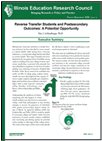 Reverse Transfer Students and Postsecondary Outcomes: A Potential Opportunity (2011-5)
Reverse Transfer Students and Postsecondary Outcomes: A Potential Opportunity (2011-5)
Eric J. Lichtenberger
Reverse transferring, or moving from a four-year institution to a community college, has been depicted in recent research as one of the major forms of student mobility. Since reverse transferring is associated with extremely low rates of degree completion, it is critical to better understand the predictors of reverse transferring and what happens to reverse transfer students once they move to a community college. This knowledge could help policymakers as they develop strategies to meet the state’s goal to increase the proportion of individuals with quality postsecondary degrees and credentials to 60% by 2025.
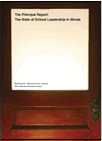 The Principal Report: The State of Leadership in Illinois (2011-4)
The Principal Report: The State of Leadership in Illinois (2011-4)
Bradford R. White and Pooja K. Agarwal
This research marks the most comprehensive profile undertaken to date of Illinois principals. In this report, we highlight emerging trends among Illinois principals, synthesize key findings from the research, and offer recommendations for policy, practice, and preparation to enhance principals’ ability to increase student achievement. With support from The Joyce Foundation, we integrate our research on principal demographics and turnover with research on principal effectiveness and a survey of current Illinois principals’ job-related beliefs and practices. More specifically, we analyze demographic and employment trends among over 7,100 individuals serving as Illinois public school principals between 2001 and 2008, statistically model principal impact on student achievement and teacher qualifications in over 3,500 Illinois public schools, and survey more than one in five active public school principals in the 2010-2011 school year.
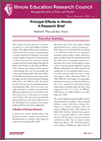 Principal Effects in Illinois: A Research Brief (2011-3)
Principal Effects in Illinois: A Research Brief (2011-3)
Bradford R. White and Alex Bowers
This report, the fourth in an IERC series on public school principals in Illinois, summarizes recent research on the characteristics associated with principal effectiveness and examines Illinois data on the relationship between principal characteristics, student proficiency, and teacher qualifications. In order to investigate the relationships between principal characteristics, teacher qualifications, and student achievements using Illinois data, we use two-level hierarchical linear growth models to measure the impact of principal characteristics on growth in student proficiency and teacher qualifications over time. In these models, the first level measures within school change over time and the second level measures differences between schools in initial school achievement or teacher qualifications status.
 The View from the Principal’s Office: Results from the IERC Principal Survey (2011-2)
The View from the Principal’s Office: Results from the IERC Principal Survey (2011-2)
Bradford R. White, Kathleen S. Brown, Erika Hunt, and Brenda K. Klostermann
This report, the third in an IERC series on public school principals in Illinois, summarizes the results of a survey of 877 Illinois public school principals conducted by the IERC in November 2010. The purpose of the survey, and of this report, is to provide policymakers and the public with a better understanding of the important role principals play in leading teaching and learning and to identify strategies to support their continuous improvement. The report begins with a description of the the survey methodology. Next, we present our findings regarding job satisfaction and work preferences, followed by an analysis of principals’ priorities and their professional practices, with an emphasis on strategies for hiring and evaluating teachers. The report concludes with a summary of findings and a discussion of implications.
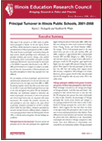 Principal Turnover in Illinois Public Schools, 2001-2008 (2011-1)
Principal Turnover in Illinois Public Schools, 2001-2008 (2011-1)
Karen J. DeAngeliss and Bradford R. White
This report is the second in an IERC series on public school principals in Illinois. This study focuses on principals’ movements during the 2001 to 2008 time period, thereby providing recent information on principal retention and turnover during a time marked by increasing school accountability and public scrutiny of principal effectiveness. For our analyses, we focus on principal – and school-level data from state administrative records and other state and national sources for the eight years from 2001 to 2008. By piecing together annual data files across those years, we are able to track each Illinois principal from one year to the next throughout the period. We use descriptive, inferential, and multivariate analyses to determine the extent of principals’ movements, as well as the personal and school-based factors that are associated with those movements.
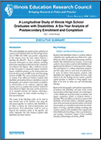 A longitudinal Study of Illinois High School Graduates with Disabilities: A Six-Year Analysis of Postsecondary Enrollment and Completion (2010-4)
A longitudinal Study of Illinois High School Graduates with Disabilities: A Six-Year Analysis of Postsecondary Enrollment and Completion (2010-4)
Eric J. Lichtenberger
This report follows 7,598 Illinois public high school graduates with disabilities from the Class of 2002 on their journeys through postsecondary education. Students identified themselves as having at least one of the following disabilities: blind or low vision, hearing impairment, learning disability, attention deficit disorder, other neurological impairment, requiring wheelchair access, other orthopedic impairment, or multiple disabilities. The students’ higher education enrollment and completion patterns were collected over a six-year period — fall of 2002 through spring of 2008– and compared with the patterns of students without a disability (N=105,537).
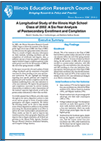 A Longitudinal Study of the Illinois High School Class of 2002: A Six-Year Analysis of Postsecondary Enrollment and Completion (2010-3)
A Longitudinal Study of the Illinois High School Class of 2002: A Six-Year Analysis of Postsecondary Enrollment and Completion (2010-3)
David J. Smalley, Eric J. Lichtenberger, and Kathleen S. Brown
There are several current initiatives on both the national and state levels related to college completion, such as the Illinois Public Agenda for College and Career Success and Complete College America. Most of the current initiatives are evidence of a shift from ensuring parity in postsecondary access to one of improving degree and certificate completion rates. In this report we provide a focused analysis of initial college enrollment and the attainment of intended outcomes for those enrolling at two-year and four-year institutions. We also highlight key findings regarding the more specific pathways and completion patterns such as the bachelor completion rates for the students transferring from a tow-year institution to a four-year institution. We explored the participation and completion outcomes by several student characteristics in addition to select characteristics of the students’ respective high schools, as well as the postsecondary institutions in which they enrolled.
The Illinois 2002 cohort study represents a vision of the results that would be available in the future with the development of the State’s longitudinal system. IERC welcomes feedback from other researchers and state policymakers on these and future findings in the interest of supporting P-20 education policy in the State of Illinois.
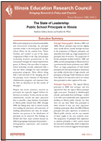 The State of Leadership: Public School Principals in Illinois (2010-2)
The State of Leadership: Public School Principals in Illinois (2010-2)
Kathleen S. Brown and Bradford R. White
With and increasing focus on school accountability and instructional leadership, the principal currently resides at the focal point of multiple reform efforts. In Illinois, a five-year effort to improve school leadership recently culminated with a new law which redesigns the state’s principal preparation programs. These efforts, along with a brief overview of the changing role of the principal, recent criticisms of educational administration programs, and responses from the field are described in the first section of this report. Funded by The Joyce Foundation.
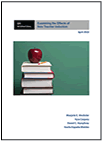 Examining the Effects of New Teacher Induction (April 2010)
Examining the Effects of New Teacher Induction (April 2010)
Marjorie E. Wechsler, Kyra Caspary, Daniel C. Humphrey, and Kavita Kapadia Matsko
For the past two years, SRI International and its partners, the Consortium on Chicago School Research and the Illinois Education Research Council, have been engaged in a research study of the induction efforts in Illinois and Ohio. The first report from the current study describe the induction policies in each state, identifies overarching factors affecting the design and implementation of induction programs, and present policies and practices most likely to raise the quality of induction programs. (Click here for a copy of the 2009 induction report).
The second phase of the study explores the relationship between various inputs-the induction and mentoring supports provided to teachers, teachers’ backgrounds, and the contexts in which they are working-and various teachers outcomes-teachers’ reports professional growth, efficacy, and retention. Funded by The Joyce Foundation.
Ex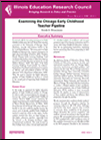 amining the Chicago Early Childhood Teacher Pipeline (2010-1)
amining the Chicago Early Childhood Teacher Pipeline (2010-1)
Brenda K. Klostermann
After completing a two-year study of the supply of and demand for early childhood teachers in Illinois (which included new certificants from higher education and the reserve pool of already-certified teachers), we found that, in general, the reserve pool could be expected to meet the increased demand if salaries reflected the training and professional experience of these teachers. We also found, however, that the reserve pool of already certified early childhood teachers was much less robust for the city of Chicago, so that it will need to rely more heavily on the certificant pipeline. But we also found that there appears to be large leakages in this higher education pipeline–especially from the “interest” to “program enrollment” stages of institutional enrollment.
Using a two-pronged approach, this study examined factors that may be preventing Chicago early childhood education students from progressing through the higher education pipeline. First, we worked with ten Chicago higher education institutions to conduct detailed analyses of the enrollment and one-year persistence data for their Fall 2006 early childhood education students. Second, we surveyed their Fall 2006 early childhood education students about conditions (e.g., student circumstances, program design) preventing them from progressing through their program. Findings from the study and policy recommendations are provided in our final report. Funded by The Joyce Foundation and the McCormick Foundations.
 The Illinois Class of 2002 and Race/Ethnicity (IERC 2009-5)
The Illinois Class of 2002 and Race/Ethnicity (IERC 2009-5)
Kathleen Sullivan Brown, Christopher M. Mullin, and Bradford R. White
Education Beyond High School Series
 The Illinois Class of 2002 and Parent Income (IERC 2009-4)
The Illinois Class of 2002 and Parent Income (IERC 2009-4)
Bradford R. White, Christopher M. Mullin, and Kathleen Sullivan Brown
Education Beyond High School Series
 The Illinois Class of 2002 and Gender (IERC 2009-3)
The Illinois Class of 2002 and Gender (IERC 2009-3)
Kathleen Sullivan Brown, Christopher M. Mullin, and Bradford R. White
Education Beyond High School Series
 The Illinois Class of 2002 and College Readiness (IERC 2009-2)
The Illinois Class of 2002 and College Readiness (IERC 2009-2)
Bradford R. White, Christopher M. Mullin, and Kathleen Sullivan Brown
Education Beyond High School Series
 The Illinois Class of 2002 — an overview: A descriptive summary four years after high school (IERC 2009-1)
The Illinois Class of 2002 — an overview: A descriptive summary four years after high school (IERC 2009-1)
Christopher M. Mullin, Bradford R. White and Kathleen Sullivan Brown
Education Beyond High School Series
Lev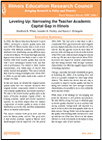 eling Up: Narrowing the Teacher Academic Capital Gap in Illinois (IERC 2008-1)
eling Up: Narrowing the Teacher Academic Capital Gap in Illinois (IERC 2008-1)
Bradford R. White, Jennifer B. Presley, and Karen J. DeAngelis
This study examines the distribution, change, and impact of the Index of Teacher Academic Capital (ITAC) in all Illinois public schools from 2001 to 2006. The ITAC is a school-level composite of five measures: teacher ACT Composite and English scores, teacher Basic Skills Test results, teacher certification status, and teacher undergraduate college competitiveness. We find that students in high-poverty and high-minority schools, especially those in Chicago, had less access to high ITAC than their counterparts elsewhere. However, high-poverty schools statewide and high-minority schools in Chicago also experienced the greatest gains in ITAC over the time period. We show the impact of ITAC by using fixed-effects models, which reveal that schools that increase their ITACs also tend to improve their achievement.
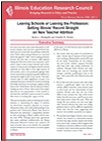 Leaving Schools or Leaving the Profession: Setting Illinois’ Record Straight on New Teacher Attrition (IERC 2007-1)
Leaving Schools or Leaving the Profession: Setting Illinois’ Record Straight on New Teacher Attrition (IERC 2007-1)
Karen J. DeAngelis and Jennifer B. Presley
This study assessed the extent of new teacher turnover from schools, districts, and the public school teaching profession in Illinois. Using data from the Illinois State Board of Education’s Teacher Service Record (TSR) and Teacher Certification Information System (TCIS) databases for the period 1986/87 through 2005/06, several cohorts of full-time teachers were tracked for five years following their initial entry into teaching to account for their movements, including reentry to the Illinois Public Schools, over time. Differences in turnover rates by teachers’ personal characteristics, such as gender, race/ethnicity, age at entry, and ACT scores, and by school characteristics, such as locale, percent low-income students, and percent minority students, were examined. The findings from this study will contribute to policy discussions concerning teacher personnel practices in Illinois.
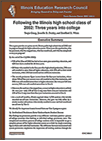 Following the Illinois High School Class of 2002: Three Years Into College (IERC 2006-5)
Following the Illinois High School Class of 2002: Three Years Into College (IERC 2006-5)
Yuqin Gong, Jennifer B. Presley, and Bradford R. White
This report provides an update on the Illinois public high school class of 2002 and its progress through the higher education system. Three years after graduation, who has persisted, who has dropped out, who has transferred, and who has completed a two-year program?
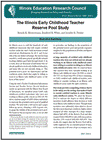 The Illinois Early Childhood Teacher Reserve Pool Study (IERC 2006-4)
The Illinois Early Childhood Teacher Reserve Pool Study (IERC 2006-4)
Brenda K. Klostermann, Bradford R. White, and Jennifer B. Presley
This report presents the results of the Illinois Survey of Early Childhood Certificants, which we distributed to over 4,000 individuals in Spring 2005. The survey found that certified teachers are willing to consider working in Illinois early childhood centers under the right conditions, and that better salaries would make such positions more attractive – it is salaries not setting that deter potential recruitees. Many details about the characteristics and work experiences of this Reserve Pool are presented in the report, along with tables and charts comparing the Reserve Pool to other groups of respondents.
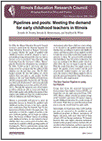 Pipelines and Pools: Meeting the Demand for Early Childhood Teachers in Illinois (IERC 2006-3)
Pipelines and Pools: Meeting the Demand for Early Childhood Teachers in Illinois (IERC 2006-3)
Jennifer B. Presley, Brenda K. Klostermann, and Bradford R. White
This study analyzes whether Illinois’ supply of early childhood teachers will be adequate to meet the increased demand brought about by the state’s new Preschool For All Plan. We find that the supply produced by the new-certificant pipeline, combined with an existing reserve pool of qualified teachers, will be sufficient to meet demand if certified teachers are offered professional salaries and the plan is phased in at a rate of about 10,000 additional students per year. Chicago will be more dependent on its new-certificant pipeline and needs to understand why so many students do not make it from “interest” to program enrollment to program completion.
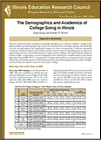 The Demographics and Academics of College Going in Illinois (IERC 2006-2)
The Demographics and Academics of College Going in Illinois (IERC 2006-2)
Yuqin Gong and Jennifer B. Presley
In order to help the state of Illinois assess the extent to which it is providing access to educational opportunities that lead to successful transitions to college and the workforce, the IERC is undertaking a six-year longitudinal study following the 113,660 students in the Illinois high school class of 2002. This report, the second one in the series, addresses college participation in the first academic year after high school graduation (AY 2002-2003).
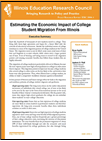 Estimating the Economic Impact of College Student Migration From Illinois (IERC 2006-1)
Estimating the Economic Impact of College Student Migration From Illinois (IERC 2006-1)
Guest authors Smith and Wall estimate the economic impact of student migration from Illinois. They conclude that Illinois loses about $700 million in tax revenues over the lifetime of Fall 2000 college migrants.
Full DocumentExecutive Summary
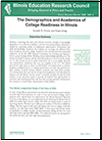
The Demographics and Academics of College Readiness in Illinois (IERC 2005-3)
Jennifer B. Presley and Yuqin Gong
In order to help Illinois policymakers and education administrators assess whether the State’s public high school graduates are ready to enter and succeed in college, the IERC is undertaking a six-year longitudinal study of the Illinois Class of 2002. This first report shows that only about one third of the Class of 2002 is college-ready, and that poor and minority members of the cohort are less likely to be ready for college when they finish high school.
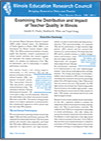 Examining the Distribution and Impact of Teacher Quality in Illinois (IERC 2005-2)
Examining the Distribution and Impact of Teacher Quality in Illinois (IERC 2005-2)
In a previous Illinois Education Research Council (IERC) policy research report, The Distribution of Teacher Quality in Illinois (IERC 2005-1), we introduced the Illinois Teacher Quality Index (TQI). The TQI is a school-level indicator of teacher quality that describes a school’s concentration of certain teacher attributes that research suggests are associated with student performance. In this report, we continue our exploration of the TQI, its distribution, and its relationship to student performance outcomes.
Full Document Executive Summary

The Distribution of Teacher Quality in Illinois (IERC 2005-1)
Karen J. DeAngelis, Jennifer B. Presley, and Bradford R. White
In this study, we look at the distribution of all 140,000 teachers in 2002-2003 among Illinois’ public schools using five teacher attributes that have been shown in previous research to be related to student performance. We created a composite measure of school teacher quality that we named the Teacher Quality Index (TQI) to combine these teacher quality characteristics into a standardized index. We use a school’s TQI as an indicator of average teacher quality at that school.
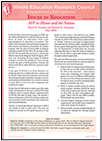 Issues in Education: AYP in Illinois and the Nation (IERC 2005-I-1)
Issues in Education: AYP in Illinois and the Nation (IERC 2005-I-1)
Hazel E. Loucks and Eleanor G. Cameron
In the few short years since its passage in 2002, the No Child Left Behind Act (NCLB) has become the focus of many in education, from state superintendents to researchers to teachers. In this Issues in Education we seek to give the reader a basic introduction to the way in which NCLB and its main measure of success, Adequate Yearly Progress (AYP), work in Illinois, and to compare Illinois’ implementation of NCLB with that of other states. We provide a history of adoption of NCLB in Illinois, explain the nuts and bolts of AYP, and finish with conclusions and recommendations.
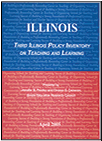 Third Illinois Policy Inventory on Teaching and Learning (April 2005)
Third Illinois Policy Inventory on Teaching and Learning (April 2005)
Jennifer B. Presley and Eleanor G. Cameron
In December 2001, the Illinois Education Research Council prepared the first Inventory on teaching and learning for Illinois in conjunction with the state’s responsibilities as a member of the National Commission on Teaching and America’s Future. A second Inventory was published in December 2002. This third Inventory provides new information that documents progress to April 2005.
C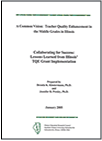 ollaborating for Success: Lessons Learned from Illinois’ TQE Grant Implementation (January 2005)
ollaborating for Success: Lessons Learned from Illinois’ TQE Grant Implementation (January 2005)
Brenda K. Klostermann and Jennifer B. Presley
Findings are presented from our case study evaluating the implementation of the IBHE’s federally funded grant, A Common Vision: Teacher Quality Enhancement in the Middle Grades in Illinois. Four sites were examined in terms of how they organized to attain the grant goals, and what aspects of organizational culture and leadership behavior contributed to success. This cross-site analysis draws lessons learned from the four sites to assist future implementation of multi-site higher education projects.
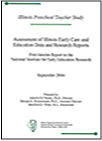 Assessment of Illinois Early Care and Education Data and Research Reports (September 2004)
Assessment of Illinois Early Care and Education Data and Research Reports (September 2004)
Jennifer B. Presley, Brenda K. Klostermann and Bradford R. White
This report provides an audit and assessment of currently available Illinois early childcare data and reports. It provides recommendations to enhance current date collection efforts and outlines the next steps to be undertaken by the IERC in its study of early education in Illinois.
 Issues in Education: School Size (IERC 2004-I-1)
Issues in Education: School Size (IERC 2004-I-1)
Karen J. DeAngelis
Responding to questions regarding what research tells us about the importance of school size to student achievement, this report reviews recent research on the topic. It concludes that to the extent that small schools are better able than large schools to create forward planning conditions, then small schools appear to be promising strategy. The report includes an extensive reference list.
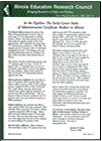 Occupational Stability of New College Graduates (IERC RN 2003-1)
Occupational Stability of New College Graduates (IERC RN 2003-1)
Jennifer B. Presley
Henke and Zahn (2001) found that 1992-93 college graduates who entered K-12 teaching were among the most stable of all employed graduates with respect to their occupations three years later. This Research Note reanalyzes Baccalaureate and Beyond data to include in the three-year comparison those who were not employed. The Henke and Zahn findings hold up.
Pre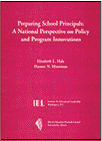 paring School Principals: A National Perspective on Policy and Program Innovations (September 2003)
paring School Principals: A National Perspective on Policy and Program Innovations (September 2003)
Elizabeth L. Hale and Hunter N. Moorman
This report is published jointly by the Institute for Educational Leadership (Washington, D.C.) and the IERC as part of its Issues in Education series. The report focuses on two areas in which state policies and programs can have particular influence on school leadership: licensure, certification and accreditation requirements, and administrator training and professional development.
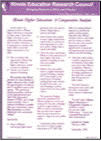 Illinois Higher Education: A Comparative Analysis (IERC 2003-3)
Illinois Higher Education: A Comparative Analysis (IERC 2003-3)
Jennifer B. Presley
Using data from national surveys, Illinois’ higher education enrollment and funding patterns are compared to other states. Conclusions are drawn regarding the state’s investment in higher education.
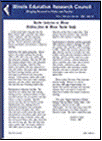 Teacher Induction in Illinois: Evidence from the Illinois Teacher Study (IERC 2003-2)
Teacher Induction in Illinois: Evidence from the Illinois Teacher Study (IERC 2003-2)
Brenda K. Klostermann and Jennifer B. Presley, Michael T. Peddle and Charles E. Trott
Using survey data collected through the Illinois Teacher Study, this report provides results about teachers’ satisfaction with their preparation courses and their participation in induction activities. It describes the relationship between participation in specific induction activities, the number of activities in which respondents participated, and intentions to remain in teaching.
 In the Pipeline: The Early Career Paths of Administrative Certificate Holders in Illinois (IERC 2003-1)
In the Pipeline: The Early Career Paths of Administrative Certificate Holders in Illinois (IERC 2003-1)
Karen J. DeAngelis
The study examines the early career paths of a random sample of individuals who earned their Illinois Type 75 administrative certificates in 1999-2000.
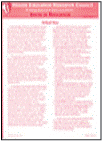 Issues in Education. Class Size and Student Achievement: Lessons from California and Tennessee (IERC 2003-I-2)
Issues in Education. Class Size and Student Achievement: Lessons from California and Tennessee (IERC 2003-I-2)
Karen J. DeAngelis
Over the past several years, states have come under increased pressure to improve the academic achievement of all students in their schools. As states have looked for ways to accomplish this task, more and more have turned to class size reduction, particularly in the early elementary grades. In this paper, we summarize evidence from two well-known, state-sponsored class size reduction initiatives and consider why these initiatives produced such different results. The approaches to class size reduction taken by these states provide lessons for other states that might be considering such programs.
Issues in Education. Learning to Read (IERC 2003-I-1)
Jennifer B. Presley
Illinois’ policy makers recognize the importance of reading competency to success in school. In this paper we summarize the findings of several recent national reports on reading and consider their findings for Illinois’ reading initiatives. The paper also provides an overview of reading programs and certification in Illinois, including the Assessment of Professional Teaching examination that will be required for initial certification in October 2003.
Teacher Supply in Illinois: Evidence From the Illinois Teacher Sstudy (December 2002)
Karen J. DeAngelis, Michael T. Peddle and Charles E. Trott
This study examines the career plans and experiences of newly certified teachers and teachers with one to five years of teaching experience in the Illinois public schools. During the Fall 2011, the three groups reported here were surveyed via telephone about their employment experiences, their intended career plans, the reasons behind the decisions of those who left teaching, and their experiences in the job market for public school teaching positions in Illinois. Between 350 and 400 surveys were completed for each of the three groups.
Illinois Policy Inventory on Teaching and Learning (December 2002)
Jennifer B. Presley for the Governor's Council on Educator Quality
In December 2001, the Governor’s Council on Educator Quality prepared its first report on teaching and learning in Illinois. It committed to updating the report annually. This 2002 Policy Inventory on Teaching and Learning provides new information that documents progress during 2002.
Assessment of Data Sources Relevant to the Supply and Quality of Illinois Primary and Secondary Educators (December 2002)
Jame M. Wilson
In November 2001 the Illinois Education Research Council received a grant from the Washington Mutual Foundation to assess the extent and usefulness of Illinois’ data systems for the study of teacher supply and demand. Data and Decision Analysis, Inc. was contracted to undertake a review of currently available data, identify data gaps, and suggest steps for moving forward. This report is in response to that charge.
The School Funding Gap: How Illinois Ranks (November 2002)
Jennifer B. Presley and Ii D. Randolph
This report extends the funding gap analysis for K-12 districts that was published by The Education Trust in August 2002. This study provides information on the national ranking of all Illinois’ school districts based on poverty quartile and state and local funding. It also examines funding adequacy, in addition to funding equity.
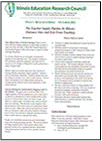 The Teacher Supply Pipeline in Illinois: Entrance Into and Exit From Teaching (October 2002)
The Teacher Supply Pipeline in Illinois: Entrance Into and Exit From Teaching (October 2002)
This Policy Research Brief summarizes findings from several studies of the Illinois teacher supply pipeline. It describes current teacher shortages, and identifies opportunities to plug leaks in the teacher supply pipeline.
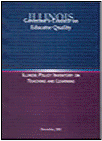 Illinois Policy Inventory on Teaching and Learning (December 2001)
Illinois Policy Inventory on Teaching and Learning (December 2001)
Jennifer B. Presley and Pamela J. Konkol for the Governor's Council on Educator Quality
As one of the partner states with the National Commission on Teaching & America’s Future (NCTAF), Illinois formed a teacher quality policy advisory council. Each state’s council is expected to document the status of state policies that support student learning through quality instruction. The Governor’s Council has prepared this report to meet that commitment.
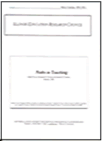 Paths To Teaching (IERC 2001-1)
Paths To Teaching (IERC 2001-1)
John B. Lee, Suzanne B. Clery and Jennifer B. Presley
This report traces the early career patterns of teachers who graduated from college in 1993. The results provide information on which college graduates became teachers, where they taught and whether they left teaching within three years.





